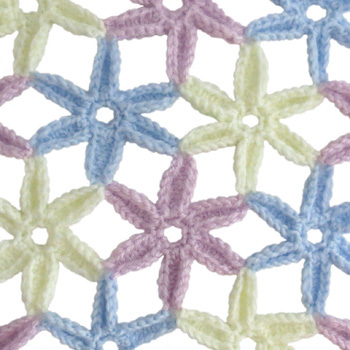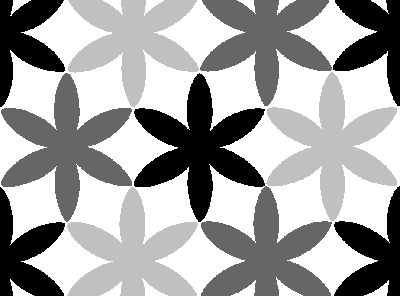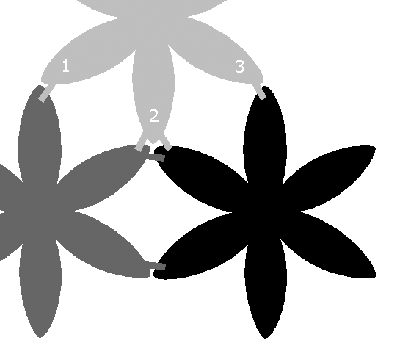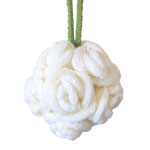Patchwork Flowers (F3)

I've been looking at a lot of crochet patterns lately. Here is my attempt to replicate a lacy patchwork fabric in knitting. The irony that a crochet hook is needed to do the cast-ons in not lost on me.
A printable version of this pattern is available.
You will need:
- scraps of yarn (double knit)
- knitting needles (2.75mm)
- crochet hook (2.75mm)
- tapestry needle
- scissors
Pattern:
(A list of abbreviations is available.)
Cast on 8 stitches using bind-off cast-on technique.
- Row 1: k6, w&t/ k4, w&t/, k2, w&t/, k2, w&t/ k4, w&t/, k6 (8)
- Row 2: cast off 6sts, k – (2)
- Row 3: p2, cast on 6 sts using bind-off cast on technique (8)
Repeat rows 1 to 3 five times to complete five petals and form the start of another. Repeat row 1 a final time and then cast off all the remaining stitches. This completes a single flower.
When you use the wrap and turn (w&t/) technique you can get a neater result by picking up the wrapped stitches on subsequent rows. I only do this with a couple of stitches for the petals because the other stitches are well hidden. Including pick-ups my petal row actually looks like this:
- Row 1: k6, w&t/ k4, w&t/, k2, w&t/, k2, w&t/ k2, pick up wrap and knit together with next stitch, k1, w&t/, k4, pick up wrap and knit together with next stitch, k1.
Joining:

The flowers are not sewn together, they are knitted together. It's much easier to do than it is to explain and will save you a lot of sewing up.
Knit your first flower. Obviously it isn't joined to anything so you don't need to worry about that yet. If you look at the tips of the petals you will notice that there are two little loops that stick up at the ends of the cast-on and cast-off rows. Those are the loops we will pick up to make joins. Similarly notice that there are two points in each petal where it will be easy to pick up a stitch. They are at the start of row 1 (just before "k6") and at the start of row 2 (just before "cast off 6").
To make a join you knit to the beginning of row 1 or 2, pick up one of the loops from a neighbouring petal, then knit that loop together with the first stitch on the needle as you begin the next row.
So far so good.
The slightly confusing part is knowing when to pick up which loop. Below is our first flower in black and our second flower in grey. The first petal of the grey flower is joined to the top loop of the bottom-left black petal at the start of row 2. The second petal of the grey flower is joined to the bottom loop of the top-left black petal. The rest of the flower is worked without joins.

It makes sense when you're doing it I swear.
In the diagram below a third flower (in light-grey) is shown. The first petal is joined to the right-side loop of the top grey petal at the start of row 2. The second petal is joined to the top loop of the top-right grey petal at the start of row 1 and the top loop of the top-left petal of the black flower at the start of row 2. Finally (gaahh!) the third light-grey petal is joined to the left loop of the top black petal at the start of row 1.

Continue to build up your patchwork by adding flowers. To keep the fabric flat each flower will need to be joined to six other flowers, two at each petal tip.
Finish off your flowers neatly. The points where the two loose ends are attached need to be sewn together for a couple of stitches to close the centre of the flower. Work the loose ends of yarn into the backs of the petals to hide them.
Notes:
Needle/Yarn Size
As with most ODDknit patterns the yarn and needle sizes in the "you will need" section are just a guide. Feel free to improvise with whatever needles and yarn you have lying around - that's half the fun!
<<< See more Flowers
© 2015 All desgins and images are copyright of ODDknit. If you enjoy the content of this website, please consider buying me a coffee at the link below.

